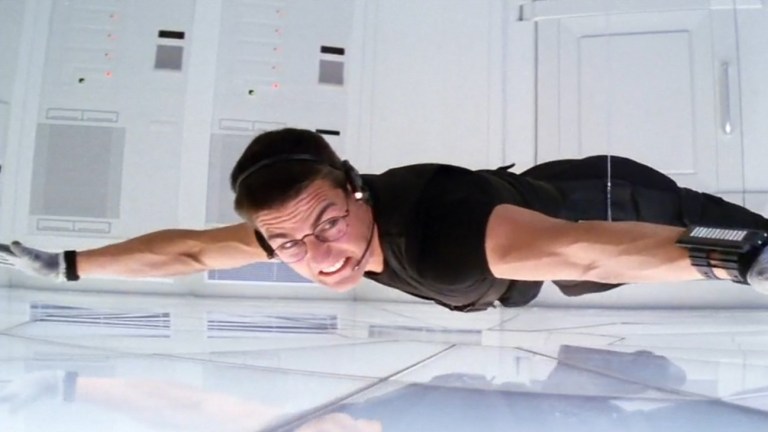Why Tom Cruise Has Never Appeared In a Mission: Impossible Game
Your mission, Tom Cruise, should you choose to accept it, is to lend your face to a game based on the Mission: Impossible series. Wait, what do you mean no?

The world of spy films is currently dominated by two franchises: James Bond and Mission: Impossible. Both are based on different mediums (novels and a TV series, respectively), but both have received multiple video game adaptations over the years. However, while the much more successful James Bond games have historically recreated the faces of the Bond actors with pixelated approximations, the Mission: Impossible games have never featured a recreation (or even an approximation) of Tom Cruise.
Actually, despite the fact that there are several games based on various Tom Cruise movies, the superstar actor has not only never appeared in a video game but has never had his likeness recreated in a video game. Why is that?
For additional context, the James Bond films have been running strong since 1962, and six (seven if you count David Niven) actors have starred as the titular character in major movies so far. While Sean Connery arguably remains film’s most iconic Bond actor, Pierce Brosnan has actually forged a unique legacy as gaming’s greatest James Bond, thanks in no small part to Rare digitizing his face for GoldenEye 007. Of course, other Bond actors (most notably, Connery, Craig, and Dalton) have at least lent their likeness to the covers of various James Bond titles.
Comparatively, the Mission: Impossible films have only been around since 1996 (though the TV series debuted in 1966), but they have always starred Tom Cruise as leading man Ethan Hunt. You might think that remarkably consistent casting would make developing Mission: Impossible games slightly easier since studios can just rely on Cruise’s likeness and voice. Instead, the main characters of the Mission: Impossible games are not only not modeled after Tom Cruise but don’t even really look like him.
Granted, we’ve only gotten two official Mission: Impossible games since the film series started (a 1998 N64 game and a 2000 Game Boy Color title), but those games clearly recreated moments from the 1996 Mission: Impossible movie. Yet, Cruise himself is nowhere to be found in either. Normally we would point the finger at movie publishers or game studios for being lazy or cheap, but turns out that Cruise himself may be the issue.
It’s long been reported that whenever Cruise signs up for a movie, he makes sure his contract contains a clause that “doesn’t allow [his] likeness to be used to make any merchandise.” That obviously includes video games but it extends to other popular pieces of merchandise like toys as well. In fact, if you scour gaming history for titles based on movies Cruise has starred in, you might notice that the characters that are usually played by Cruise in the movies almost deliberately look nothing like him in the games.
Case in point, in the Minority Report film, Cruise plays protagonist John Anderton. However, in the often-forgotten game based on that movie (Minority Report: Everybody Runs), the John Anderton character looks and sounds nothing like Cruise. Hilariously, the developers went so out of their way to ensure the character did not resemble Cruise that they gave John olive skin, blonde hair, and the voice of Clancy Brown.
Some games based on Tom Cruise movies have gone even further than that to ensure that they don’t feature even a vague Tom Cruise lookalike. For instance, instead of controlling Cruise’s character, Ray Ferrier, in the two War of the Worlds games, players instead command an alien tripod and vaporize humanity’s forces in basic shoot-em-up sidescrollers. In the (surprisingly excellent) game based on Tom Cruise’s The Mummy, The Mummy Demastered, players control a faceless Prodigium soldier instead of the film’s protagonist, Nick Morton.
Admittedly, this answer raises even more questions. Most notably, why doesn’t Tom Cruise want his likeness used for merchandise? Many other stars go out of their way to license their likenesses in order to enjoy the considerable profits such merchandise often generates. Well, Wired theorizes (in a tongue-in-cheek manner) that Cruise’s decision could be rooted in some Scientology laws, but that’s never really been more than an off-handed theory, at best. Maybe Cruise wants the residuals from merch sales to go to other people, or maybe his clause is based on a variation of the old myth that taking a photograph steals a part of your soul. Given Cruise’s famously…eccentric nature, you kind of have to entertain a number of possibilities.
For what it’s worth, there at least appeared to be a time when Cruise wasn’t outright opposed to the entire concept of video games. In fact, Kotaku previously shared a story about a time when Cruise reportedly called Bungie’s offices after getting stuck in the company’s 1994 title, Marathon. While it’s difficult to picture Tom Cruise finding the time to sit down and play a computer game (and there is always room to suspect embellishment regarding that particular story), that incident at least suggests that Cruise isn’t specifically denying gamers the privilege of controlling Ethan Hunt over some kind of long-held grudge against the medium.
In any case, that seemingly airtight clause all but ensures you’ll never get to play a Mission: Impossible game featuring Cruise’s face unless you make one yourself. Even then, we wouldn’t recommend sharing it.
